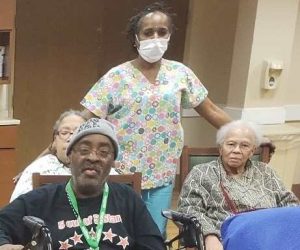
Serving Butler, Clermont, Hamilton & Warren Counties in Southwest Ohio
Our Voices are Louder, Together
To bring about meaningful change for the long-term care of our elders, some of these trends will require changes to our laws, rules, and regulations.
Our long-term care ombudsmen in Southwest Ohio have conversations, listen, gather information, and gain insight from the residents we advocate for in nursing homes, assisted living and group homes. Residents tell us their experiences about the quality of care they receive and their quality of life. We see trends – sometimes troubling trends – and, like you, we want things to be better.
Within our region, we work on addressing these trends to improve the quality of care and quality of life in Southwest Ohio. Each regional Ombudsman program also reports these trends to the Office of the State Long-Term Care Ombudsman (SLTCO) in Columbus, Ohio. As a group, we advocate for improvements for all Ohio residents, and we speak with elected officials about the concerns of their constituents. The SLTCO office compiles statewide data and insights in a report to the Administration on Community Living once a year. Adding your voice can make a difference!

Make Your Voice Heard
Our legislators need to hear what you or your loved one have experienced in long-term care. Tell your story, or your loved one’s story, of living in long-term care. Your voice will help inform the necessary legislative reforms for better care of our elders.
STEP 1 - Locate your elected representatives.
STEP 2 - Review the suggested guidelines before you begin your letter or call.

Read through the suggested guidelines we offer to create a succinct, impactful letter to your legislators.
STEP 3 – Write or call your representative today.

Together, we can make a difference in the lives of people relying on long-term care services and supports, in a facility or their own home.

Sign up to receive periodic email updates on legislative advocacy from Pro Seniors.
Follow Pro Seniors on social media. We are @ProSeniors or @ProSeniorsInc
Current Issues to Watch
Act Now to Reauthorize the Older Americans Act
The Older Americans Act (OAA) was the first federal level initiative aimed at providing comprehensive services for older adults. It created the National Aging Network comprising the Administration on Aging on the federal level, State Units on Aging at the state level, and Area Agencies on Aging at the local level. Signed into law by President Lyndon Johnson, the network supported by this act provides funding—based primarily on the percentage of an area’s population 60 and older—for nutrition and supportive home and community-based services, disease prevention/health promotion services, elder rights programs, the National Family Caregiver Support Program, and the Native American Caregiver Support Program.
Please act now to ask our elected representatives to reauthorize the Older Americans Act. The Older Americans Act expired when Congress failed to reauthorize it in late 2024. Use the process outlined above to identify your members of Congress and tell them what these services mean to you and your community. Or, you can use the form provided by the National Council on Aging to contact your legislators.
Read more about the history of the Older Americans Act here.
Thank you for caring about older members of our community, and for lending your voice.
Staffing shortages are now at acute levels across the state and the nation.
Both the quality of care and quality of life are diminished when there are not enough staff available to provide for the resi. There are a host of issues that arise when there are not enough staff to properly care for residents. Both the quality of care and quality of life are diminished.
LTCCC’s analysis of federal nursing home staffing data for Q2 2023 shows that nearly four in five (78.8%) nursing home residents live in understaffed facilities providing less than the 4.1 Hours Per Resident Day (HPRD) needed to deliver sufficient clinical care and avoid unnecessary resident harm. The 4.1 HPRD threshold was determined by a landmark 2001 federal study.
How can I make a difference?
Please contact your state and federal representatives today to advocate for more than 4.1 nursing hours per resident per day.
Thank you for caring about residents living in nursing homes, and for lending your voice.
Recently the Governor of Ohio established the Task Force for Nursing Home Quality and Accountability.
Click here to read the latest progress of the Governor’s Task Force.

